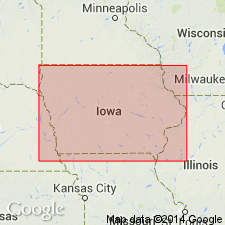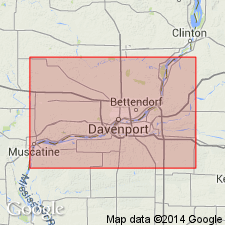
- Usage in publication:
-
- Farmers Creek Member
- Modifications:
-
- Named
- Dominant lithology:
-
- Dolomite
- AAPG geologic province:
-
- Iowa shelf
Summary:
The Hopkinton Dolomite was previously divided on the basis of paleontologic units, but is here divided into lithologic members to facilitate interregional correlations based on sea-level curves. The 12-m-thick rock unit corresponding to the CYCLOCRINITES beds of the Hopkinton is here named the Farmers Creek Member in eastern IA and may also be traced to northwestern IL. Consists of tan, massive, very finely crystalline to micritic dolomite. The pentamerid brachiopod HARPIDIUM MAQUOKETA dominates the fauna of the upper two-thirds of the member; the green alga CYCLOCRINITES occurs throughout the entire unit. Overlies the Marcus Member and underlies the Picture Rock Member (new), both of the Hopkinton. Age is Early Silurian (Llandoverian).
Source: GNU records (USGS DDS-6; Reston GNULEX).

- Usage in publication:
-
- Farmers Creek Member
- Modifications:
-
- Areal extent
- AAPG geologic province:
-
- Wisconsin arch
Summary:
According to author, one of his primary aims in this report is to strongly encourage adoption of IA nomenclature in adjacent IL. The only major change is the incorporation of the Sweeney and Marcus as members within the Hopkinton and replacement of the Racine (as used by Willman, 1973) with upper members of the Hopkinton, the Scotch Grove Formation, and the Gower Formation. The Racine is restricted to WI as it has been misapplied in the Quad Cities area and is probably equivalent to only the upper part of the Scotch Grove. The Hopkinton in the Quad Cities area of IA and IL is divided into (ascending) Sweeney, Marcus, Farmers Creek, and Picture Rock Members. The Farmers Creek Member lithically contrasts with overlying and underlying Hopkinton units, and is characterized by finely skeletal-moldic dolomites. In the middle part, diverse and abundant fauna of crinoids and brachiopods are present. Farmers Creek is most productive portion of the Silurian aquifer. Age is Llandoverian.
Source: GNU records (USGS DDS-6; Reston GNULEX).
For more information, please contact Nancy Stamm, Geologic Names Committee Secretary.
Asterisk (*) indicates published by U.S. Geological Survey authors.
"No current usage" (†) implies that a name has been abandoned or has fallen into disuse. Former usage and, if known, replacement name given in parentheses ( ).
Slash (/) indicates name conflicts with nomenclatural guidelines (CSN, 1933; ACSN, 1961, 1970; NACSN, 1983, 2005, 2021). May be explained within brackets ([ ]).

